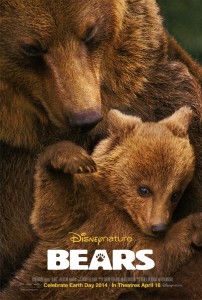Bears
Posted on April 17, 2014 at 6:00 pm

This year’s Disney Nature release for Earth Day is “Bears,” the story of an Alaskan bear named Sky and her twin cubs, Scout and Amber, their trek from the den where they’ve hibernated all winter to a place where they can find enough food to sustain themselves through the summer and the next year’s hibernation. John C. Reilly is the genial narrator in a highly relatable story that has adventure, humor, peril, discovery, and some very powerful maternal love. There’s a reason that we call our toughest human mothers mama bears.
As in the previous entries in this series, the footage is stunning, both the breathtaking grand vistas of snow and mountains in the five million acre national parkland on the Alaskan peninsula to the tiny faces of the brand-new cubs. And it is filled with “how did they get that” moments, with no indication until the final credit sequence of any human presence. The water sequences are especially thrilling.
The narration is less intrusively anthropomorphic than some of the previous entries in this series. While there are many dangers and some animal battles and predators, it is also less sad and scary than African Cats. Parents of younger children should know that it appears at one moment that one of the cubs has been killed, but it turns out that he is fine.
Sky and her tiny cubs wake up in the den she prepared for giving birth and dozing through the winter. She is depleted and the tiny cubs are not quite ready for the week-long trek through the snow to find a place where the salmon are running, and Sky can have access to the 90 pounds of protein a day she will need to survive the next hibernation. The trio face many threats. They reach a pack of other bears (the cubs’ are very excited to find others of their species), but Magnus, the over-1000 pound alpha male, is capable of eating the cubs if no other food is available. An outcast from the pack is also after them. The hunt for salmon takes them to the shore, where there are clams to eat, but it is also dangerous when the tide comes in.
The devotion and persistence of these animals is a powerful reminder that family connections link all species. With this peek into their world, we are more aware of our own.
Parents should know that this movie includes some peril and animal fighting. It appears at one point that one of the main characters has been killed but he turns out to be fine.
Family discussion: Why was Chinook an outcast? How does Sky teach the cubs what they need to know? Who is your role model and why is it important to have one? How would the story be different if it was from the point of view of one of the other animals or the salmon?
If you like this, try: “Chimpanzee” and “African Cats”

